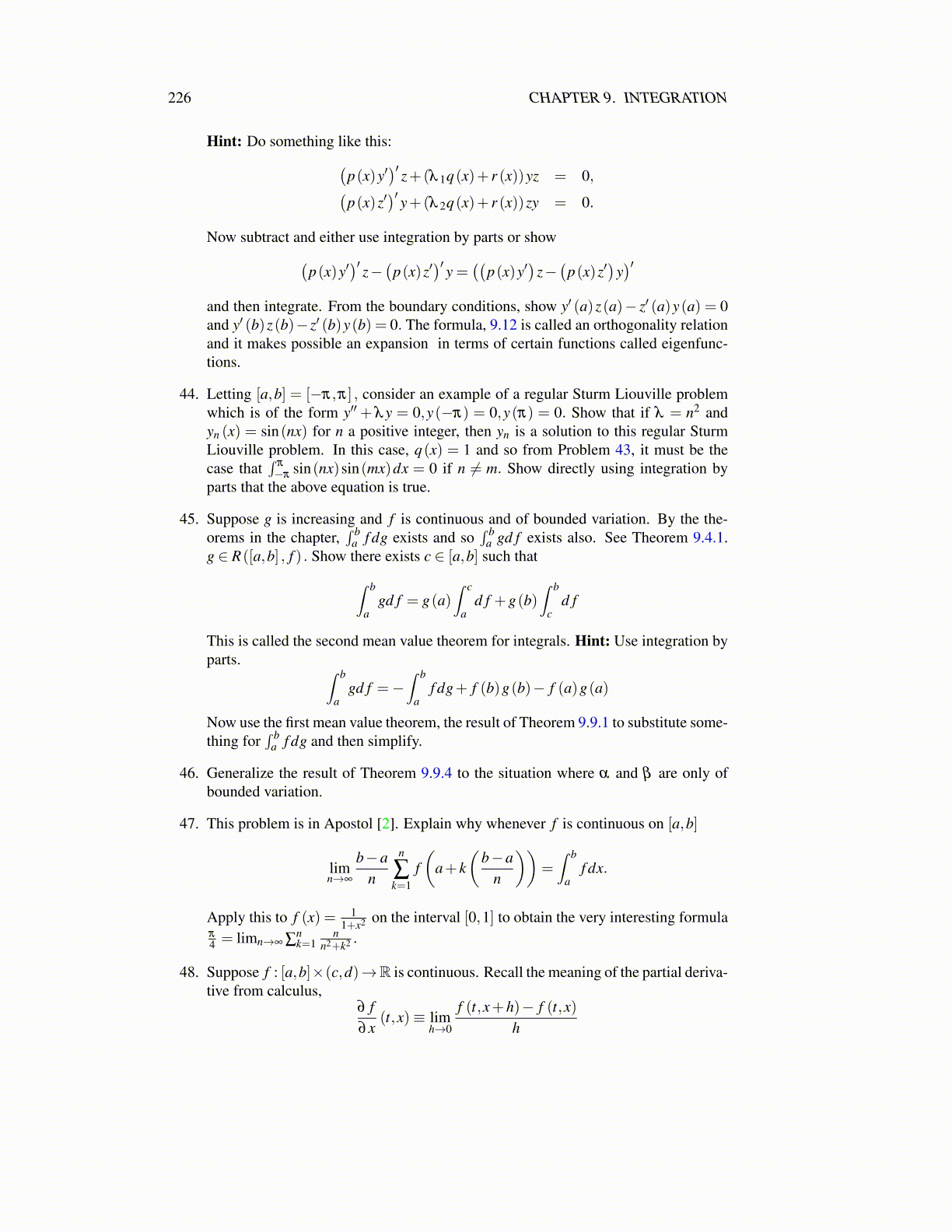
226 CHAPTER 9. INTEGRATION
55. The problem in Apostol’s book mentioned in Problem 54 does not require nan tobe decreasing and is as follows. Let {ak}∞
k=1 be a decreasing sequence of non-negative numbers which satisfies limn→∞ nan = 0. Then ∑
∞k=1 ak sin(kx) converges
uniformly on R. You can find this problem worked out completely in Jones [19].Fill in the details. This is a very remarkable observation. It says for example that∑
∞k=1
1k1+ln(k) sin(kx) converges uniformly.
Always let p be so large that (p−1)ap−1 < ε . Also, note that |sinx| ≤ |x| for allx and for x ∈ (0,π/2) ,sinx ≥ x
2π. (You could just graph sinx− x
2πto verify this.)
Also, we can assume all ak are positive since there is nothing to show otherwise.Define b(k) ≡ sup
{ja j : j ≥ k
}. Thus k → b(k) is decreasing and b(k)→ 0 and
b(k)/k ≥ ak.
Suppose x < 1/q so each sin(kx)> 0. Then∣∣∣∣∣ q
∑k=p
ak sin(kx)
∣∣∣∣∣≤ q
∑k=p
b(k)k
sin(kx)≤q
∑k=p
b(k)k
kx≤ b(p)(q− p)1q≤ b(p) (9.14)
Next recall that
n
∑k=1
sin(kx) =cos( x
2
)− cos
((n+ 1
2
)x)
2sin( x
2
) ≡ mn (x) ,
|mn (x)| ≤ n, |mn (x)| ≤1
sin(x/2)if x ∈ (0,π) .
This is from the process for finding the Dirichlet kernel. Then use the process ofsummation by parts to obtain in every case that∣∣∣∣∣ q
∑k=p
ak sin(kx)
∣∣∣∣∣≤ ∣∣aqmq (x)−ap−1mp−1 (x)∣∣+ ∣∣∣∣∣q−1
∑k=p
mk (x)(ak−ak+1)
∣∣∣∣∣≤ 2ε +
q−1
∑k=p|mk (x)|(ak−ak+1)≤ 2ε +
1sin(x/2)
(ap−aq) (9.15)
We will only consider x ∈ (0,π) for the next part. Then for such x, It remains toconsider x∈ (0,π) with x≥ 1/q. In this case, choose m such that q > 1
x ≥m≥ 1x −1.
Thus x < 1m ,
1m+1 < x. Then from 9.15, 9.14,
∣∣∣∣∣ q
∑k=p
ak sin(kx)
∣∣∣∣∣≤≤b(p)︷ ︸︸ ︷∣∣∣∣∣ m
∑k=p
ak sin(kx)
∣∣∣∣∣+∣∣∣∣∣ q
∑k=m+1
ak sin(kx)
∣∣∣∣∣≤ b(p)+2ε +
1sin(x/2)
(am+1−aq)≤ b(p)+2ε +4π
xam+1
≤ b(p)+2ε +4π
xb(m+1)
m+1≤ b(p)+2ε +
4π
xb(m+1)x
≤ b(p)+2ε +4πb(p)≤ 2ε +17b(p) , limp→∞
b(p) = 0.